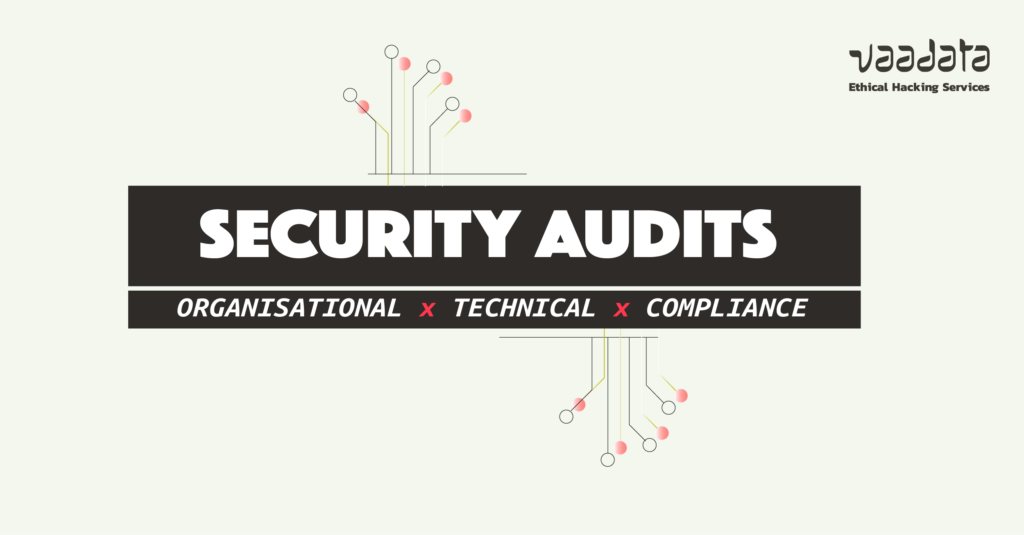With cyberattacks on the rise, carrying out an IT security audit has never been a higher p 2024-8-6 21:55:42 Author: www.vaadata.com(查看原文) 阅读量:3 收藏

With cyberattacks on the rise, carrying out an IT security audit has never been a higher priority for businesses.
Web applications, mobile apps, APIs, cloud infrastructures, connected objects, networks and people – nothing is spared. As a result, security audits have become an essential tool for all types of business. Whether technical audits, organisational security audits or compliance audits, there are numerous solutions for securing an information system and countering risks.
In this article, we present the different types of IT security audit. We will detail their principles and objectives, as well as the methodology, procedures, assessments and tests carried out during these audits.
What is a Security Audit?
A security audit is a diagnosis at a given moment of the state of an information system or organisation. It aims to identify vulnerabilities and potential risks, as well as to evaluate security measures in order to propose concrete recommendations for strengthening data and infrastructure protection against external and internal threats.
These audits are essential to guarantee the availability of the information system and the integrity and confidentiality of data, in other words to control risks. To achieve this, all types of security audit must be carried out over the long term, as the landscape of risks and regulations is constantly evolving.
Why Carry Out a Security Audit?
The multiplication of regulations, the increase in attacks and the omnipresence of IT systems in all sectors have made security audits an essential step.
There are many contexts in which a security audit can be conducted:
Preventing and countering cyberattacks
A security audit plays a crucial role in preventing and countering cyberattacks. By carrying out an audit, a company obtains an in-depth assessment of its security practices.
This helps detect vulnerabilities and weaknesses that could be exploited by attackers. By identifying these gaps, the organisation can take corrective action to strengthen its defences.
A security audit also helps to verify that security controls are correctly implemented and operating effectively. This includes not only the technologies used, but also security processes and policies.
By ensuring that all these aspects are aligned with best practice and industry standards, the organisation reduces the risk of human error and vulnerabilities that could be exploited.
Ensuring compliance with standards and regulations (ISO, SOC 2, NIS 2, DORA, etc.)
A security audit is necessary to ensure compliance with various standards and regulations such as ISO, SOC 2, NIS 2, DORA, etc.
We will look at compliance audits in detail later in this article.
Turning cybersecurity into a competitive advantage
Carrying out regular security audits proves that a company takes the protection of its data and that of its customers seriously. Furthermore, customers or prospects, especially in sensitive sectors such as finance or healthcare, are more inclined to trust and choose a company that proves its ability to protect their information.
Indeed, when a company can prove that it has robust security measures, it stands out from its competitors. In fact, most of the time, presenting the results of a security audit is a sine qua non condition for signing contracts with certain companies (key accounts in particular).
Finally, following a security audit and under certain conditions, it is possible to obtain certifications, which are valuable assets in today’s competitive market.
Training employees and raising their awareness on cybersecurity challenges
The report issued following a security audit generally identifies areas for improvement, including the need for training. Employees play an essential role in a company’s security. According to Verizon’s latest DBIR report, 75% of successful attacks are caused by human error.
So training and raising awareness among employees on cybersecurity challenges is a key step following a security audit. This may involve training in web application security or on the risks of social engineering, phishing being the preferred attack vector.

What are the Different Types of Security Audit?
There are several types of IT security audit, each with its own objectives and methodologies. They often complement each other and address different aspects of an organisation’s security.
In this article, we will focus on organisational security audits, compliance audits and technical audits.
Organisational security audits
An organisational security audit, as the name suggests, aims to assess a company’s internal organisation. This type of audit enables to determine the current state of the IS security and identify risks.
An organisational security audit can be carried out on a regular basis to review the security processes in place and seek to improve them or ensure their reliability. The aim is also to check compliance with current regulations or the company’s certifications.
With this in mind, it may be useful to conduct an organisational audit every year, specifically for holders of ISO-type certifications or to check whether the processes in place are still compatible with the RGPD, for example.
The procedure for an organisational audit can be adapted to the structure of the company and the size of the system to be audited. Indeed, the audit will not have the same scope depending on the size of the company and the complexity of the IS.
Several aspects are assessed during an organisational security audit.
Audit of the organisation from a security point of view
On one hand, the audit focuses on the organisation, with an assessment of the following elements:
- The level of compliance of the security processes in place with regulations or certifications held
- Information security policies
- Information management, including HR and third parties (suppliers)
- Communication security control (protection of infrastructure and information on networks, whether in-house or with an external entity such as a supplier or partner)
- Access controls implemented within the company
Technical audit of the organisation
The other half of the security audit concerns the technical side, with an inspection of several components, including:
- Inventory and classification of information to identify needs for improvement
- Information system acquisition and maintenance processes
- IS physical and environmental security (including premises security)
- Incident management (mainly those related to information security and integrity)
- The business continuity plan in the event of an incident (cyberattack, natural disaster)
- Cryptographic measures in place
Compliance audits
Compliance audits are designed to assess whether the audited entity complies with established standards. In some cases, they may be carried out with the aim of obtaining or renewing certification.
There are a multitude of standards and certifications, some of which apply to specific business sectors. Examples include:
GDPR
GDPR is a European legislation that aims to protect individuals’ personal data. This (mandatory) legislation applies to any entity wishing to reside within the European Union or processing data from EU residents.
It includes explicit consent to data collection, implementation of appropriate security measures and notification of data breaches.
ISO standards
These standards, such as ISO/IEC 27001, establish international standards for information security management. ISO compliance audits assess whether an organisation meets the requirements specified by these certifications.
This includes the implementation of an information security management system, security risk management, employee awareness, monitoring and continuous improvement processes, etc.

SOC2
SOC2 compliance was created to give customers the assurance that their supplier is undertaking adequate security measures to protect their data. In particular, SOC2 certification is regarded as the benchmark for data security for suppliers in the cloud.
However, it is also suitable for all companies providing technology or SaaS services that store and process data.
NIS2
NIS2 (“Network and Information Security 2”, an extension of the NIS 1 directive) is a European directive aimed at increasing the level of security of major players in 10 strategic business sectors.
The directive requires entities to implement security measures to reduce their IT attack surface and to report any security incident.
DORA
The DORA (Digital Operational Resilience Act) regulation requires financial entities to report major ICT (Information and Communication Technology) incidents promptly and comprehensively to market surveillance authorities.
The aim of this regulation is to strengthen the security and competitiveness of the European financial market in the face of increasing cyber attacks.
Whatever the standard, a compliance audit includes analysing procedures, documents and practices to ensure that they comply with established requirements, as well as identifying non-compliances and proposing corrective measures.
Technical security audits
A technical security audit is an assessment of an organisation’s IT systems, networks and infrastructure to identify vulnerabilities and security risks.
It involves examining configurations, software, security policies and management practices to ensure protection against potential threats and attacks, and recommends improvements to enhance security.
One method of technical security auditing is to simulate attacks on a specific target to detect and exploit vulnerabilities. This is also known as penetration testing or pentesting.
In fact, it is possible to carry out a security audit on all types of target. Let’s take a closer look.
Web security audit
The aim of a web security audit is to identify the technical and logical vulnerabilities of a website or web application in order to correct them and improve protection against potential attacks.
A web security audit includes a search for vulnerabilities both on the server side and in all functionalities, including (but not limited to):
- Analysis of server configuration
- Injection testing (SQL, XSS, HTLM, etc.)
- Examination of third-party components used
- Verification of access controls
To find out more, please refer to our article: Web Application Penetration Testing: Objective, Methodology, Black Box, Grey Box and White Box Tests.

Mobile security audits
A mobile security audit consists of a static and dynamic analysis of an iOS or Android application to identify and correct vulnerabilities.
Mobile application testing is generally based on the MASVS standard. This standard, developed by OWASP (Open Web Application Security Project), provides a framework for ensuring the security of mobile applications. It is divided into several security levels and categories:
- Secure data storage
- Cryptographic features
- Authentication and session management
- Secure communications
- Secure development practices
- Protection against reverse engineering
For more information, please consult our article: Mobile Application Penetration Testing: Objective, Methodology and Testing Scope.

API security audit
An API security audit can be carried out independently or integrated into the scope of a web or mobile security audit, taking into account the vulnerabilities specific to this type of interface.
Whatever the type of API (REST, GraphQL, etc.), tests are carried out on the functionalities as well as on the hosting infrastructure.
For more information, please refer to our article: API Penetration Testing: Objective, Methodology, Black Box, Grey Box and White Box Tests.
Internal network audit
An internal network audit consists of evaluating the security of a network from the point of view of an attacker who has managed to penetrate it.
Tests include the analysis of servers, network equipment, workstations, Wi-Fi, Active Directory and other critical components.
For more information, see our article: Internal Penetration Testing: Objective, Methodology, Black Box and Grey Box Tests.
IoT security audits
The aim of an IoT security audit is to detect vulnerabilities in the various layers of the IoT in order to secure the entire connected object environment.
Thus, the tests can cover:
- Hardware: reverse engineering, memory dumps, etc.
- Firmware: analysis of open ports, cryptographic analysis, etc.
- Communications protocols: listening to exchanges, denial of service, etc.
- Associated services: web or mobile interfaces, APIs, etc.
Technical Conditions of a Security Audit
During a technical security audit, 3 specific approaches can be distinguished. These approaches, which can be coupled, correspond to different levels of information provided to the auditors to carry out the tests.
Black box security audit
The black-box approach is the closest to an external attack. It refers to an audit in which the auditors are given no indication prior to performing the tests.
For more details on this type of audit, please consult our article: Black Box Penetration Testing: Objective, Methodology and Use Cases.
White box security audit
White box auditing is the complete opposite of black box auditing. Here, a lot of information is provided to the auditors: source code, admin accounts, etc.
This approach makes it possible to detect vulnerabilities that would not necessarily be obvious to find without in-depth knowledge of the target system.
If you would like to find out more, please refer to our article: White Box Penetration Testing: Objectives, Methodology and Use Cases.
Grey box security audit
Grey box testing is somewhere between the black box and white box approaches. In this case, some information is provided to the auditors depending on the objective and the target being tested.
The aim of this approach is to simulate a situation in which an attacker has already succeeded in obtaining an account with restricted rights, gaining access to a non-public platform, and so on.
如有侵权请联系:admin#unsafe.sh